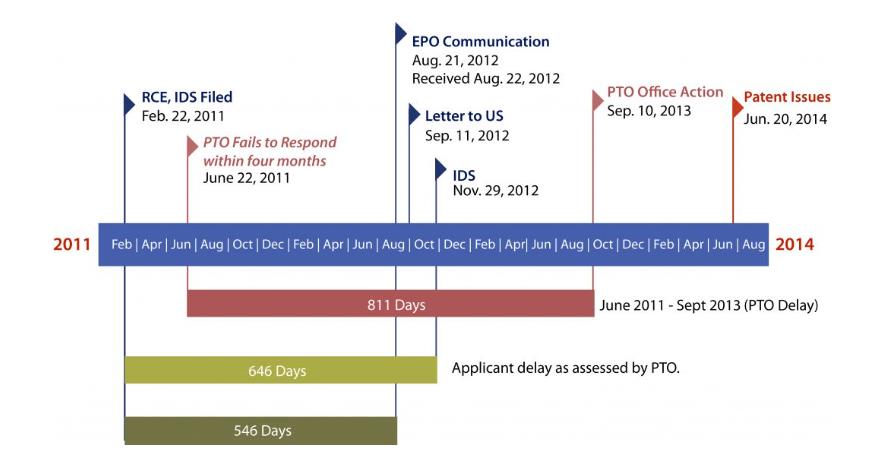Federal Circuit Finds That the USPTO Cannot Reduce PTA for a Time Period Where the Applicant Could Not Have Advanced Prosecution
Client Alert | 15 min read | 01.31.19
In Supernus Pharmaceuticals, Inc. v. Iancu, the Federal Circuit held that the USPTO improperly imposed a Patent Term Adjustment (PTA) deduction for “applicant delay” during a period when the applicant “could have done nothing to advance prosecution.” The PTA deduction at issue in Supernus was charged under 37 CFR §1.703(c)(8) for an Information Disclosure Statement (IDS) filed after a Request for Continued Examination (RCE) had been filed, but the decision could have broader implications. This decision could substantially increase PTA in situations where applicant delay was subtracted due to filing a “supplemental paper” under 37 CFR §1.704(c)(8).
35 USC § 154(b)(2)(C) provides for a deduction from any PTA award “equal to the period of time during which the applicant failed to engage in reasonable efforts to conclude prosecution of the application.” The PTA statute expressly delegates to the USPTO the authority to “prescribe regulations establishing the circumstances that constitute a failure of an applicant to engage in reasonable efforts to conclude processing or examination of an application.”
The USPTO exercised this delegated authority in 37 CFR § 1.704(c), which lists a number of circumstances that constitute “applicant delay” under the PTA statute. The USPTO uses 37 CFR § 1.704(c)(8) to charge applicant delay when the applicant files an IDS after having filed an RCE, but before the next Office Action or Notice of Allowance.
In Supernus, the PTA deduction at issue was charged for an IDS filed after the filing of a RCE. Applicants filed a RCE on February 22, 2011. On August 21, 2012, the Applicant was notified by the European Patent Office (EPO) that an opposition had been filed in a related European application. On November 29, 2012, Applicants filed an Information Disclosure Statement (IDS) with the USPTO citing the opposition papers.
Upon issuance of the patent, the USPTO assessed 646 days of applicant delay based upon the time from the filing of the RCE to the filing of the IDS. Below is an image from the Federal Circuit decision illustrating the relevant time periods. The dark and light green bars are the time periods at issue here.

Supernus challenged the PTA deduction in the U.S. District Court for the Eastern District of Virginia, arguing that out of the 646-day period between the filing of the RCE and the IDS, it was entitled to at least 546 days because the European opposition could not have been cited earlier than the date it was communicated by the EPO. The district court, granting summary judgement in favor of the USPTO, upheld the PTA determination based on the Federal Circuit decision in Gilead v. Lee, which upheld the USPTO’s application of 37 CFR § 1.704(c)(8) in a situation where an IDS was filed after a response to a restriction requirement.
The Federal Circuit decision here, authored by Judge Reyna and joined by Judges Dyk and Schall, reversed the district court. The Federal Circuit first explained why Gilead did not foreclose Supernus’s arguments, finding that the question at issue in Supernus—whether the USPTO may reduce PTA by a period that exceeds the “time during which the applicant failed to engage in reasonable efforts to conclude prosecution” under 35 U.S.C. § 154(b)(2)(C)(i)—was not decided in Gilead. In Gilead, the court held that the regulation “is a reasonable interpretation of the [PTA] statute” to the extent it includes “not only applicant conduct or behavior that result in actual delay, but also those having the potential to result in delay irrespective of whether such delay actually occurred.”
The Federal Circuit next applied the Chevron framework for reviewing an agency’s interpretation of a statute it administers, and determined that the statute directly addressed the issue here. The court explained:
"A plain reading of the statute shows that Congress imposed two limitations on the amount of time that the USPTO can use as applicant delay for purposes of reducing PTA. First, the statute expressly requires that any reduction to PTA be equal to the period of time during which an applicant fails to engage in reasonable efforts. Second, the statute expressly ties reduction of the PTA to the specific time period during which the applicant failed to engage in reasonable efforts."
The Federal Circuit applied “widely understood” meanings of “equal” and “during” to conclude that “PTA reduction cannot exceed the period of time during which an applicant failed to engage in reasonable efforts… if there is no period of time the applicant could have but failed to engage in reasonable efforts, there can be no reduction to the PTA.” The Court held:
"[T]here was no action Supernus could have taken to advance prosecution of the patent during the 546-day period, particularly because the EPO notice of opposition did not yet exist. Here, the USPTO’s interpretation of the statute would unfairly penalize applicants, fail to incentivize applicants not to delay, and fail to protect applicants’ full patent terms."
The Federal Circuit accorded no deference to the USPTO’s interpretation of the regulation at issue because it was inconsistent with the plain language of the statute:
"[t]he USPTO’s interpretation of the PTA statute applied in these circumstances exceeds the statutory limitations for PTA reduction and therefore, the USPTO actions are 'in excess of statutory . . . authority.'"
Finding that the PTA statute was “plain, clear and conclusive” on the matter, the Court found its Chevron analysis to be complete. The Federal Circuit reversed the district court decision, and remanded for further proceedings consistent with its opinion.
Although this ruling clearly addresses periods of applicant delay based on filing an IDS after the filing of an RCE, it could have broader implications for any period in which there was no action that the applicant could have taken to conclude prosecution. However, the decision does not eliminate reduction of PTA for all “supplemental papers” filed after the filing of a response, only those in which there was no “failure to engage in reasonable efforts to conclude prosecution.” Patentees are strongly encouraged to review all PTA calculations of applicant delay, and file requests for reconsideration with the USPTO when appropriate.
Contacts
Insights
Client Alert | 6 min read | 04.16.24
Navigating the AI Intellectual Property Maze - Key Points From Congressional Hearing
On April 10, 2024, the U.S. House of Representatives, Judiciary Committee Subcommittee on Intellectual Property convened Part III to an ongoing discussion and exploration of artificial intelligence (AI) and intellectual property (IP) rights. The session, “Artificial Intelligence and Intellectual Property: Part III - IP Protection for AI-Assisted Inventions and Creative Works,” delved into the nuanced debate over what IP protections should exist for AI-generated or AI-assisted works.
Client Alert | 5 min read | 04.15.24
Making the EU Courts More Efficient for Trade-Related Decisions
Client Alert | 1 min read | 04.15.24
New FAR Part 40 to Address Supply Chain and Information Security Requirements
Client Alert | 1 min read | 04.11.24
U.S. Chamber Submits Comments on the FAR Council’s Proposed Rule Regarding Pay Transparency




